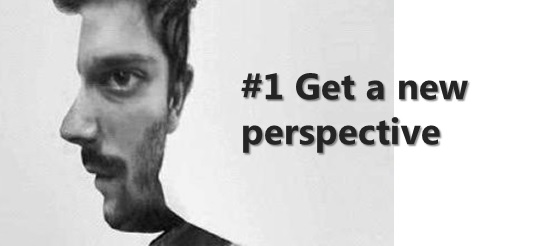Change Your Perspective is Post #1 in a series from a presentation entitled 11 Great Creative Slip-Ups: The Most Common Mistakes in Brainstorming. The introduction to the series begins here.
The Problem: Starting the brainstorm with the wrong objective
Brainstorming is creative problem-solving. Typically, the ‘problem’ is something preventing a business goal or result from being achieved.
Obviously, the business goal is most important. However, that doesn’t necessarily mean the brainstorm should start with the business goal only.
To put it another way, the business objective is strategic. It is usually written . The problem is a strategically focused goal often doesn’t lend itself to creative possibilities.
The problem becomes more acute when the organisation, department or agency conducts frequent brainstorms. They typically use the same business objective, over and over. That means the brainstormers get the same strategic direction without any guidance (or changes) on a creative solution.
This slip-up might remind you of a well-known quote by Albert Einstein. “Insanity is doing the same thing over and over but expecting different results.”
Solution: Change your perspective
Here are three suggestions to try:
1. Start with a creative objective instead of a business objective
If the business (strategic) objective anchors the direction of the project, campaign or assignment, consider commencing a brainstorm with a creative objective.
Creative objectives open up the direction, offering a vision, or a desire of the future, for people to explore through ideas in the brainstorm. It might look something like, as a real example from a hotel chain.
- Business objective: Generate positive coverage for the opening of Brand H’s new resort-style hotel.
- Creative objective: Celebrate the fantasy of an overseas resort-style holiday without having to fly out of the country.
It doesn’t have to be SMART in the Strategic sense, but I like to use “SMART” in the creative sense to inspire the imagination, if not change the perspective of the people in the brainstorm.
- Silly – have fun with the direction, explore beyond the basic, creative ideas don’t grow out of serious meetings!
- Meaningful – all good ideas are emotional, they tap into something in the heart
- Aspirational – they need to be something to look forward to, into a better future, a desire for the new
- Radical – no Big Idea is ever safe. E.V.E.R.
- Truly Out There – go big, take a risk, do something that challenges the status quo
2. Change the perspective of the objective
Try to reframe the objective with a different perspective, such as paraphrasing the objective or writing it from the end user’s point-of-view.
For example, a pharmaceutical company came to us to help re-launch a prescription cream that would combat the very ugly but non-life-threatening yellow nail fungus. (No one said all brainstorms were pretty.)
Anyway, we re-wrote the objective of “generate awareness” in four different ways:
- Change people’s notion of what’s acceptable.
- Bring an embarrassing topic out in the open – but in a comfortable way. Maybe even add a bit of fun to it?
- Make the product appear in a natural place in people’s lives.
- Tap into conversations people have every day.
Our team began brainstorming where and when toe nails ‘appear’ naturally in a person’s day. We immediately jumped to manicures and pedicures.
To make a long story short, our campaign eventually came down to educating nail salon employees who in turn would talk to their customers about how to alleviate the yellow nail fungus. Of course, our first audiences were women, but wives and girlfriends are remarkably good at encouraging their husbands, boyfriends and partners.
It worked so well, we played it out further with an idea of creating “toe trucks,” which were simply mobile vans driving around the city giving out free manicures and pedicures. In turn, this allowed us to get our messages out and promote the prescription product.
3. Look at the problem from a different perspective
Ask someone entirely unrelated to the situation, product or category to help change the perpsective to solve the problem.
- Talk with experts or opinion leaders in different environments.
- Ask a child what he or she might do.
- Ask someone who “reframes” as part of their job: a photographer, a journalist, a blogger, a social media influencer.
- Turn the problem into a game of metaphors. “This problem is like …” A pharma company found its users didn’t like the taste of the pills. Unfortunately, they couldn’t change or mask the taste, so we brainstormed “This problem is like getting children to eat their vegetables.”
- Brainstorm the problem from the point of view of different occupations – especially ones totally unrelated to your problem – and ask yourself how they might solve your problem.
For a crisis campaign, a client wanted us to develop themes and icons to conceptualize a campaign to warn patients about potential issues or crises. We created a list of occupations which have or use early-warning or preventative devices. A politician uses public polls, a chef uses a timer, a lifeguard uses flags, a conductor uses a baton, a policeman uses a speed camera, and a farmer uses a scarecrow in the fields to scare off crows.
So, we delved further into the farmer’s warning signals, one of which was the common weather vane. With its distinctive shape and four directions which also spells out “NEWS”, the vane became the campaign’s new logo and theme, as well as a digital newsletter to educate its end users.
If you want to return to the original article with links to the other ‘Slip-Ups’, click here.



No comment yet, add your voice below!